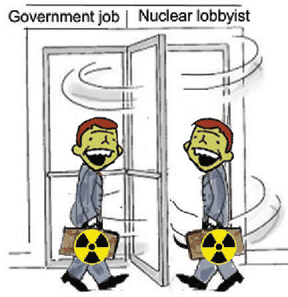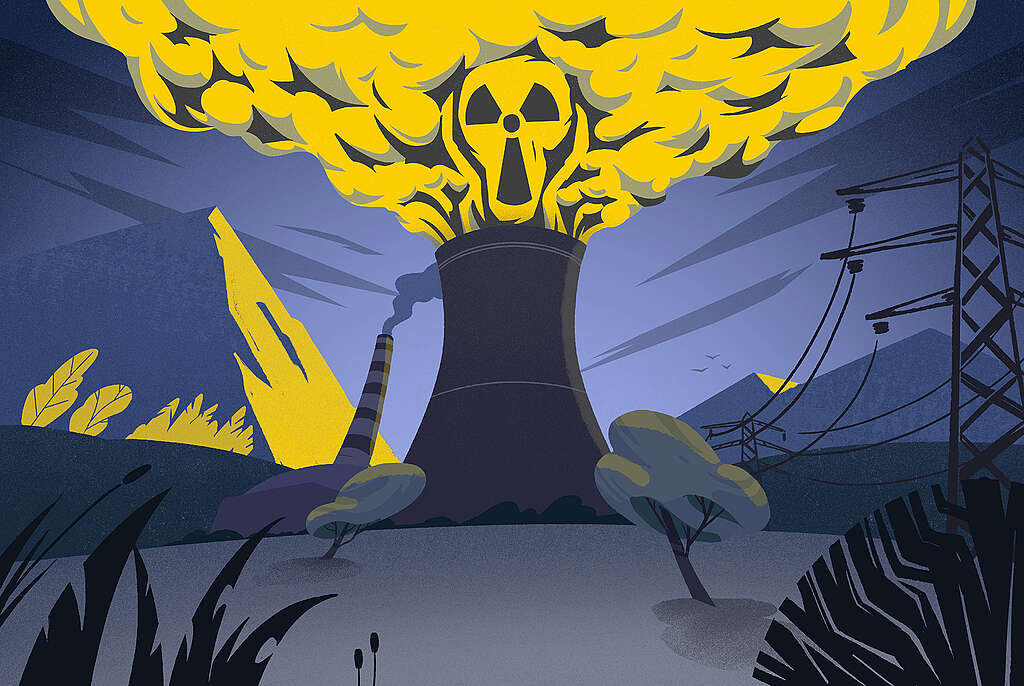Corporate lobbying heats up around governments’ nuclear power plans despite concerns from anti-nuclear advocates

“The nuclear industry and the government are so tightly entwined that you would have difficulty finding some kind of air space in between them. You have, for example, nuclear industry people that get jobs in the government. It’s a revolving door.”
Critics say nuclear too costly and slow to build while supporters back it as a climate solution
Investigative Journalism Foundation, KATE SCHNEIDER, 6 JUNE, 24
“…………………………….. Fears of nuclear meltdowns have long stymied the expansion of nuclear power across Canada. However, with Canada newly committed to achieving net-zero emissions by 2050, the past few years have spurred a new wave of support for nuclear power development.
Yet, some opposition MPs and analysts worry that the recent embrace of nuclear power by governments in Canada has been a result of lobbying by an influential industry more intent on turning a profit than hitting climate targets.
“We’ve got a very, very powerful nuclear special-interest lobby, and we don’t have politically powerful lobbies for energy efficiency or wind or solar,” said Jack Gibbons, chair of the Ontario Clean Air Alliance and a former Toronto Hydro commissioner. “As a result, our political leaders are making bad decisions.”
Last July, the Ontario government announced the largest expansion of nuclear power in Canada in decades. It intends to add a 4,800-megawatt extension to the Bruce Nuclear Generating Station, one of the biggest nuclear power plants in the world.
The site is located on Lake Huron in the northern Ontario municipality of Kincardine — just over 200 km northwest of Toronto — and, while owned by the provincial government, is operated by private company Bruce Power.
Last week, Bruce Power registered a new lobbyist in the province to discuss the “successful refurbishment of Ontario’s nuclear fleet” as well as what it sees as overly onerous regulations, offering to help the government “identify areas for red tape reduction in several sectors.”
The lobbyist, Daniel Levitan, is currently employed by government relations firm Rubicon Strategy. Like several other nuclear industry lobbyists identified by the IJF, Levitan previously worked for the government. He worked for 10 years in external relations for Hydro One, Ontario’s largest electricity distribution utility, starting in 2013. Before that, he was a director of communications and senior policy adviser for several Ontario government departments.
Neither Bruce Power nor Daniel Levitan responded to requests for comment.
Competition for the contract for new nuclear reactors at the Bruce site has also spurred on a lobbying battle between AtkinsRéalis (formerly known as SNC-Lavalin) and Westinghouse, as reported by The Logic last month.
AtkinsRéalis employs both Jean Chrétien, the former Liberal prime minister, and Mike Harris, the former Progressive Conservative premier of Ontario, as the co-chairs for their public relations campaign.
The biggest surge in lobbying, however, has perhaps been around funding for small modular reactors (SMRs)……………..
In February last year, Natural Resources Canada launched a funding program offering $29.6 million to encourage the development of SMRs.
Companies working on the technology are eager to take advantage of federal funds. Ultra Safe Nuclear Corporation (USNC), a Seattle-based nuclear technology company, lobbied the government on eight different occasions last year seeking money for “Canada’s first small modular nuclear reactor.”
BWXT Canada Ltd., a nuclear reactor manufacturer, is also registered to lobby at the federal level, hoping to “examine new funding opportunities for nuclear energy and its operations in Canada.”BWXT Canada has lobbied key ministers and government officials this year, including Jonathan Wilkinson, minister of energy and natural resources; Mairead Lavery, president and CEO of Export Development Canada; Jean-Yves Duclos, minister of public services and procurement; and Ben Chin, one of the prime minister’s top advisers.
BWXT Canada announced in April that it was investing $80 million to expand its Cambridge, Ont. headquarters, increasing its manufacturing capacity to meet the growing demand for nuclear technologies, including SMRs.
BWXT said, “We are interested in updating all levels of government about our operations in Canada, our expansion project at our Cambridge facility and how we are supporting Ontario’s nuclear projects and Canada’s clean energy targets.” USNC did not respond to a request for comment.
“The nuclear industry and the government are so tightly entwined that you would have difficulty finding some kind of air space in between them.” – Susan O’Donnell, St. Thomas University
Industry groups such as the Canadian Nuclear Association and the Organization of Canadian Nuclear Industries have also been lobbying officials in the past year, as have several unions including the International Union of Operating Engineers. The Ontario Society of Professional Engineers is also registered to lobby in Ontario.
Reached for comment, Snigdh Baunthiyal, a spokesperson for the Canadian Nuclear Association, provided a statement to the IJF that said, “We have asked for the Federal government’s support to accelerate the deployment of strategic tools such as ITCs [investment tax credits] and CMT [corporate minimum tax] to ensure Canada retains its leadership role and meets its domestic and international climate and energy security objectives.”
None of the other organizations responded to requests for comment.
In total, four nuclear power plants currently operate across Canada, producing about 12.7 per cent of Canada’s electricity. Three plants — with 16 operational reactors — are located in Ontario, while a fourth housing a single reactor is in Lepreau, New Brunswick.
Alongside the privately operated Bruce Nuclear Generating Station, the other two Ontario-based plants in Pickering and Darlington are operated by Ontario Power Generation (OPG), a Crown corporation.
OPG has lobbied the federal government 21 times so far this year regarding “issues pertaining to federal legislation, policies and programs with respect to OPG’s existing nuclear operations or new nuclear opportunities including small modular reactors,” according to its lobbying registration.
The Darlington site is already halfway through a refurbishment costing $12.8 billion while the Ontario government recently announced plans to refurbish four of the reactors at the Pickering plant starting in 2027.
Construction of an SMR at Darlington is scheduled to be completed in 2028. Last July, the Ford government announced that this SMR would soon be followed by an additional three at the site, projected to go online by the mid-2030s.
Jennifer Stone, a spokesperson for OPG, said that these projects will help the province “meet the growing demand for clean electricity for decades to come.
“As OPG helps secure Ontario’s clean energy future, these projects also generate good jobs and drive economic growth across the province both at our facilities and through Ontario’s robust nuclear supply chain,” added Stone.
NB Power plans to build an SMR at its Lepreau site in conjunction with ARC Clean Technology Inc.
NB Power acknowledged the IJF’s request for comment, but said it would be unable to provide a response before deadline.
While Canada’s only operating nuclear plants are in Ontario and New Brunswick, the uranium used to fuel them comes entirely from Saskatchewan, largely via uranium mining giant Cameco.
Cameco engaged in a lobbying campaign in March targeting various federal government officials, including those at Natural Resources Canada and the Impact Assessment Agency of Canada. According to its most recent lobbying registration, Cameco wants to “advocate for the federal government to include nuclear energy as a major component in Canada’s greenhouse gas/carbon reduction strategy.” Cameco is also registered to lobby in Saskatchewan.
Dale Austin, Cameco’s director of government relations and one of its registered lobbyists, previously worked as a director of the policy analysis and coordination division for Natural Resources Canada as well as a director of policy coordination for the Canadian Nuclear Safety Commission.
Susan O’Donnell is an adjunct research professor at St. Thomas University and a core member of the Coalition for Responsible Energy Development in New Brunswick. O’Donnell said the influence of the industry extends beyond what appears in the official lobby registry.
“‘Do they even need to lobby?’ is what I would say. Because they’ve got all their people in the government,” said O’Donnell.
“The nuclear industry and the government are so tightly entwined that you would have difficulty finding some kind of air space in between them. You have, for example, nuclear industry people that get jobs in the government. It’s a revolving door.”
Worries over safety risks and environmental implications of nuclear power have been around for decades, embodied by incidents like the Chornobyl and Fukushima disasters.
However, the concerns expressed today by anti-nuclear advocates seem to revolve more around nuclear being too costly or excessively slow to build.
“It just doesn’t make any economic sense. And it doesn’t make any climate sense,” said Gibbons. “Wind and solar, combined with storage, can keep our lights on at less than half the cost of new nuclear reactors.”
…………………………………O’Donnell said that given Canada’s commitment to decarbonize its electricity grid by 2035, the idea that new nuclear power projects, especially SMRs, will be ready in time is simply unrealistic.
New nuclear reactors typically take 10 to 15 years to build. And besides the first Darlington SMR, no other SMRs in Canada will be operational until at least the early 2030s.
“On the other hand, we do have mature technologies, which are wind and solar, we do have [storage] technology that’s coming along tremendously,” said O’Donnell. “We’ve got the technology now if we’re serious about meeting our targets.”…………….. https://theijf.org/nuclear-power-lobbying
No comments yet.
-
Archives
- December 2025 (223)
- November 2025 (359)
- October 2025 (377)
- September 2025 (258)
- August 2025 (319)
- July 2025 (230)
- June 2025 (348)
- May 2025 (261)
- April 2025 (305)
- March 2025 (319)
- February 2025 (234)
- January 2025 (250)
-
Categories
- 1
- 1 NUCLEAR ISSUES
- business and costs
- climate change
- culture and arts
- ENERGY
- environment
- health
- history
- indigenous issues
- Legal
- marketing of nuclear
- media
- opposition to nuclear
- PERSONAL STORIES
- politics
- politics international
- Religion and ethics
- safety
- secrets,lies and civil liberties
- spinbuster
- technology
- Uranium
- wastes
- weapons and war
- Women
- 2 WORLD
- ACTION
- AFRICA
- Atrocities
- AUSTRALIA
- Christina's notes
- Christina's themes
- culture and arts
- Events
- Fuk 2022
- Fuk 2023
- Fukushima 2017
- Fukushima 2018
- fukushima 2019
- Fukushima 2020
- Fukushima 2021
- general
- global warming
- Humour (God we need it)
- Nuclear
- RARE EARTHS
- Reference
- resources – print
- Resources -audiovicual
- Weekly Newsletter
- World
- World Nuclear
- YouTube
-
RSS
Entries RSS
Comments RSS



Leave a comment